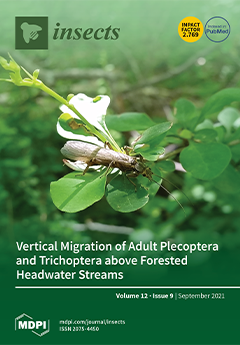By any measure, such as abundance, species diversity or geographic range, the
Simulium ornatum species group is one of the most successful Palearctic taxa of black flies. To explore potential diversity in this group in the Tian Shan range of Central Asia, we
[...] Read more.
By any measure, such as abundance, species diversity or geographic range, the
Simulium ornatum species group is one of the most successful Palearctic taxa of black flies. To explore potential diversity in this group in the Tian Shan range of Central Asia, we focused on Kyrgyzstan, in which three nominal morphospecies have been recorded. Among our samples, we morphologically identified
S. mesasiaticum Rubtsov and a second possible species tentatively identified as
S. ferganicum Rubtsov. By analyzing banding patterns of the larval polytene chromosomes, we discovered two fixed inversions, two sex-linked rearrangements, and 19 autosomal rearrangements, including supernumerary B chromosomes. The chromosomal data indicate minimal diversity of only one or two species across the surveyed area of nearly 50,000 km
2. Mitochondrial DNA (CO1) sequences fell into three distinct clusters, possibly representing separate species. The chromosomal, molecular, and morphological data indicate that Kyrgyz populations are unique within the
S. ornatum group, but the data sets are not entirely congruent. Thus, reconciling data sets and assigning existing names is tentative.
Simulium mesasiaticum is linked with undifferentiated sex chromosomes, one of the three CO1 clades, and higher elevations, whereas
S. ferganicum is tenuously associated with differentiated sex chromosomes, a separate CO1 clade, and lower elevations. These associations leave one Kyrgyz larva, which is in a third CO1 clade, unlinked to a formal species name. Our analyses also indicate that
S. ornatum Meigen
sensu stricto, contrary to previous reports, does not occur in Kyrgyzstan and should be deleted from the country’s faunal list.
Full article






